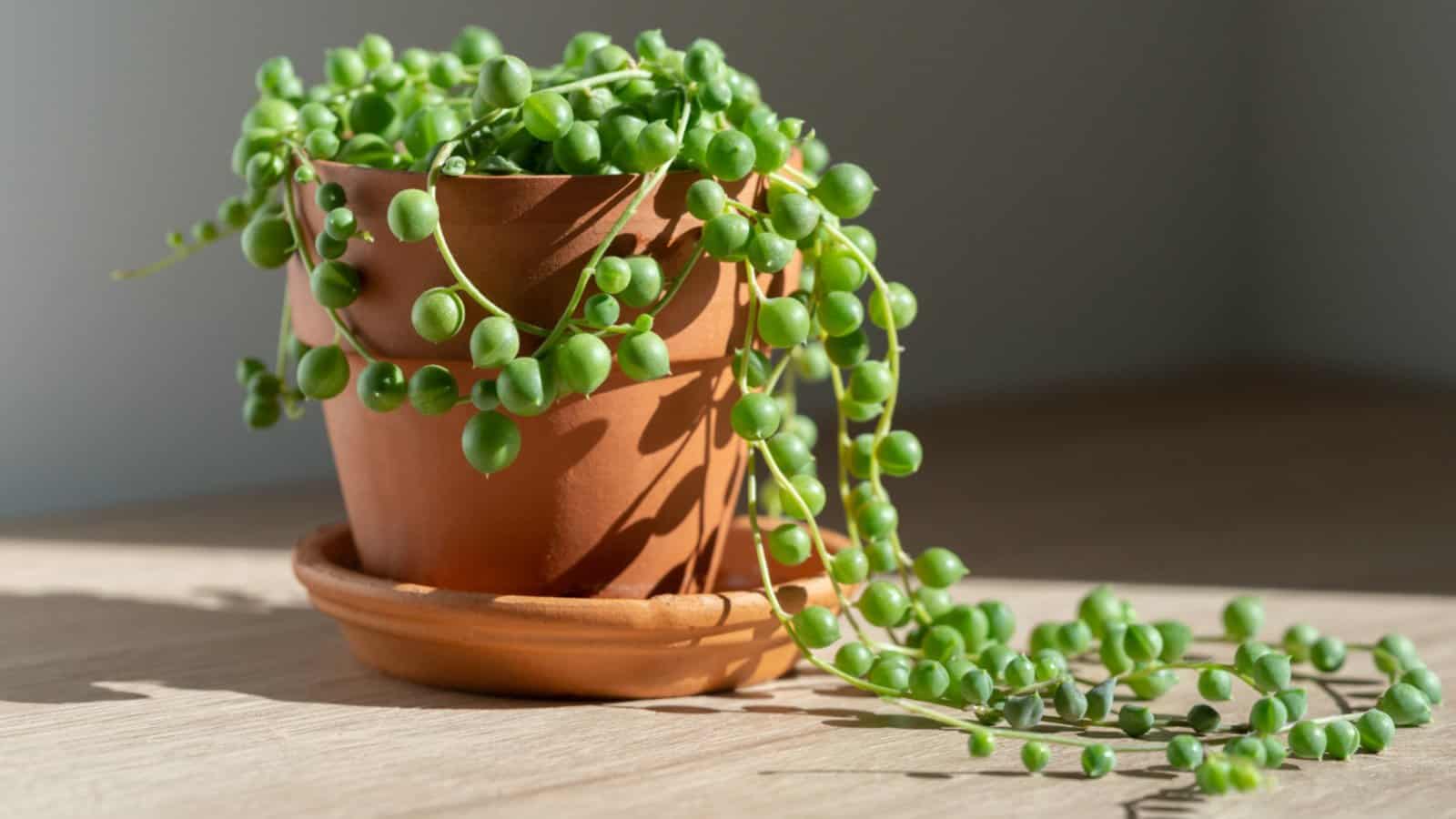If you’ve ever spotted a plant that looks like a delicate cascade of tiny green beads, chances are you’ve met the String of Pearls. With its long, trailing stems and perfectly round leaves, this eye-catching succulent brings a unique texture to any indoor jungle or sunny patio space.
While it can be just a touch fussy if its needs aren’t met, once you find the right rhythm, String of Pearls grows quickly and rewards you with stunning draped foliage—and even a few unexpected flowers.
Let’s walk through how to keep this stylish succulent happy and thriving in your space.
Table of Contents
- Where String of Pearls Comes From
- What Makes String of Pearls So Unique
- Light Requirements: Bright, Indirect Sun Is the Sweet Spot
- Soil: Fast-Draining Is Non-Negotiable
- Watering String of Pearls: Less Is Definitely More
- Temperature and Humidity Preferences
- Fertilizing: Just a Light Seasonal Boost
- Pruning and Training: For Shape and Strength
- Outdoor Care for String of Pearls
- Propagating String of Pearls
- Common Problems and How to Fix Them
- Is String of Pearls Pet-Safe?
Where String of Pearls Comes From
Native to the dry regions of southwest Africa, Senecio rowleyanus is part of the Asteraceae (daisy) family.
In the wild, it trails along the ground, rooting where it touches soil and using its bead-like leaves to store water during drought.
Indoors, it’s grown primarily for its whimsical trailing form, often spilling beautifully from hanging baskets, shelves, or tall planters.
What Makes String of Pearls So Unique
Those tiny spherical leaves aren’t just cute—they’re clever.
Each “pearl” acts like a miniature water reservoir, helping the plant survive long periods without moisture.
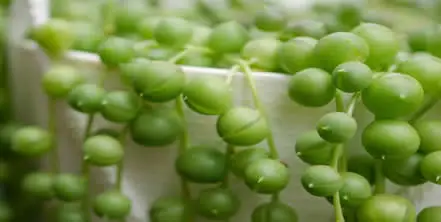
If you look closely, you’ll even see a faint translucent strip on each one, known as a “leaf window,” which allows light to penetrate and help with photosynthesis.
In spring or summer, mature plants may produce small, fuzzy white flowers with a light cinnamon scent.
While not the main attraction, the blooms are a lovely bonus.
Light Requirements: Bright, Indirect Sun Is the Sweet Spot
String of Pearls loves light but is sensitive to sunburn.
The ideal location is one that offers bright, indirect light for most of the day.
Indoors, a south- or west-facing window filtered with a sheer curtain is perfect.
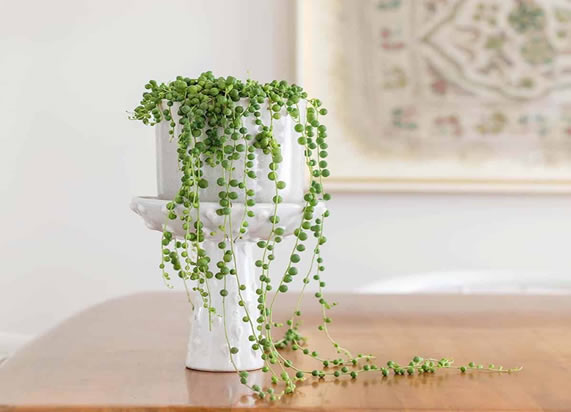
If you’re growing it under lower light conditions, the plant may become leggy or lose its spherical shape.
In that case, consider adding a grow light to give it the extra brightness it needs.
Outdoors, partial sun or dappled light is ideal.
Morning sun followed by afternoon shade works well—especially in hot climates.
Soil: Fast-Draining Is Non-Negotiable
This plant does not tolerate soggy roots. Use a gritty, well-draining cactus or succulent mix, or make your own blend using:
-
2 parts cactus/succulent potting mix
-
1 part coarse sand or perlite
-
1 part pumice or fine gravel
Make sure your pot has a drainage hole, and avoid using pots that retain excess moisture (like glazed ceramic or plastic without holes).
Watering String of Pearls: Less Is Definitely More
Because the leaves are full of stored water, overwatering is the quickest way to harm this plant.
Let the soil dry out completely between waterings, then soak thoroughly and allow excess water to drain out.
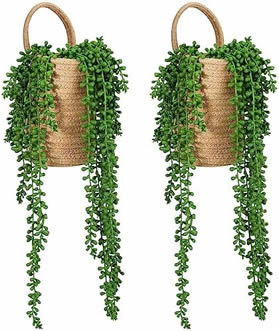
During spring and summer, you may water every 2–3 weeks depending on your environment.
In winter, reduce watering to once a month or less.
- Signs of underwatering: shriveled or flattened pearls
- Signs of overwatering: mushy, translucent pearls or blackening stems
If you’re unsure—wait a few more days. This plant forgives underwatering more than overwatering.
Temperature and Humidity Preferences
String of Pearls thrives in warm, dry conditions.
Ideal temperatures range between 70–85°F during the day and no lower than 50°F at night.
Humidity isn’t necessary—in fact, high humidity can increase the risk of rot.
If you’re growing it in a bathroom or humid climate, ensure plenty of airflow.
Avoid placing it near cold drafts or air conditioning vents, which can stress the plant.
Fertilizing: Just a Light Seasonal Boost
Feed String of Pearls during its growing season (spring and summer) with a diluted cactus or succulent fertilizer every 4–6 weeks.
Skip fertilizing in fall and winter when the plant is resting.
Too much fertilizer can lead to weak growth or root burn, so always dilute more than you think you need.
I find that a good quality cacti feed, like this one, works really well with this particular succulent.
Pruning and Training: For Shape and Strength
Pruning helps maintain the plant’s shape and encourages fuller growth.
If the strands get too long, sparse, or leggy, snip them back with clean scissors.
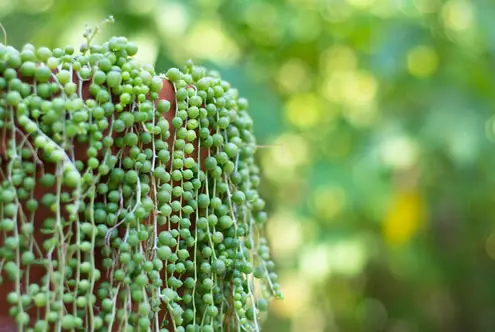
You can replant the trimmed pieces to fill in bald spots or propagate new plants (more on that in a moment).
Trailing strands can also be trained along a trellis or draped around shelves to create a soft, cascading effect.
Outdoor Care for String of Pearls
If you live in USDA zones 9–11, String of Pearls can be grown outdoors year-round.
In cooler climates, it can enjoy the outdoors during warmer months but should be brought inside before temperatures drop below 50°F.
Tips for growing it outside:
-
Place in a shaded patio or under a tree where it gets dappled light
-
Protect from rain or overly wet conditions—especially in containers
-
Use raised planters, hanging baskets, or rock gardens with excellent drainage
-
Watch for pests like aphids or mealybugs, especially during the summer months
If conditions are right, it can grow fast and drape several feet over the course of one season.
Propagating String of Pearls
String of Pearls is super easy to propagate from stem cuttings—and you can do it in soil or water.
Soil propagation:
-
Snip off a healthy stem about 4–6 inches long
-
Remove the pearls from the bottom 1–2 inches of the stem
-
Lay the stem on top of well-draining soil or tuck the bare portion just beneath the surface
-
Mist lightly every few days until roots form, then switch to normal succulent care
Water propagation (less common but fun to try):
-
Remove lower pearls from a stem and place it in a small jar with just the bare stem submerged
-
Change the water every few days
-
Once roots appear, transfer gently to soil
You can also coil a long cutting on top of soil in a spiral pattern—each pearl node that touches the soil will try to root.
Propagation is best done in spring and summer for fastest results. For a more in-depth look at propagating these succulents read our article How to Propagate String of Pearls (Senecio rowleyanus): Multiply the Magic of This Trailing Beauty.
Common Problems and How to Fix Them
-
Shriveled pearls: Usually from underwatering or too much direct sun
-
Mushy stems or black spots: A sign of overwatering or root rot
-
Leggy strands: Not enough light—move it closer to a window or supplement with a grow light
-
Leaves falling off: Can happen after transplant shock, overwatering, or too little light
With a little observation and quick action, most issues are easy to turn around.
Is String of Pearls Pet-Safe?
Unfortunately, no—String of Pearls is considered toxic to cats, dogs, and humans if ingested.
Keep it well out of reach of children and pets, especially since those little beads can look tempting to curious paws.
Final Thoughts
String of Pearls (Senecio rowleyanus) is more than just a trendy trailing succulent—it’s a playful, sculptural beauty that adds charm and movement to your plant displays.
With the right balance of bright light, dry soil, and gentle care, it will reward you with long, cascading strands that look like living jewelry.

